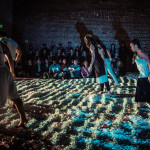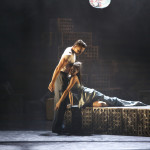Leigh Donlan reports from ODC in San Francisco:
Los Angeles based choreographer Arianne MacBean and her Big Show Co. brought an introspective performance to ODC this past weekend, reminding us that dance theater is alive and well in Southern California. Her first work, The People Go Where the Chairs Are, was a humorous examination of the creative process. The second and world première of Present Tense was an intelligent though glum take on the current state of our interpersonal relations. It was certainly an entertaining evening, though the first half of the program felt like an overeager plea from MacBean to her audience, making the intermission ‘Artist Talk’ a bit awkward, as MacBean continued to explain the meaning of the piece in person. Sometimes you just have to allow the work to speak for itself.
And MacBean does have compelling ideas. The People Go Where the Chairs Are – inspired by the book The Chairs Are Where The People Go by Sheila Heti and Misha Glouberman about how to live, work, make art and play in contemporary life – was quite clever. The four company members – Angelina Attwell, Genevieve Carson, Brad Culver and Max Eugene – took us through the difficult and often ridiculous process of creating a dance from the seed of a concept. It began and ended with the performers holding chairs in the air; the intervening segment was full of personality conflicts, episodic meltdowns, fruitless ideas and wayward tangents. Ultimately, no dance is produced – only talked about – a predicament that many artists know too well. While the piece could have been shortened to maximize effect, MacBean’s savvy dialogue and accessible characters made it endearing. Culver’s brilliantly witty delivery was spot on, as he mumbled to himself like a neurotic Woody Allen.
Though I do have to say that one of my favorite characters was a participating audience member. During an exploratory tangent, the company attempts to remove “the fourth wall” and push the limits of theater. Audience members were lured into chairs on stage, and an adorable young man – wearing skintight Ouija board pants and sporting a head full of curls – seemed to really connect with Max Eugene, to the point that he wouldn’t leave the stage, still clinging to Eugene’s side as the scene changed. I’m not sure if this was choreographed, but the playfulness and chemistry worked.
Present Tense, with an original jazz score composed by Ivan Johnson, felt like more of a dance work than the first. Two dancers stood paralyzed by anguish, while two others sporadically propelled themselves across the floor on their backs. Tension builds as the dancers begin to verbally confront each other, saying things like “You could be so much better. I could really love you.” They all start running around with outstretched hands, yelling “Grab my hand!” but no one slows down long enough to allow that to happen. Then the accusations start flying – “It’s your fault!” “You come here!” “No, you come here!” – until they’re exhausted and alone. The women begin to run backwards while the men lie in heaps on the floor, extending their bodies out to reach briefly, but quickly contracting back into the fetal position. Then the women crouch on the floor, babbling insincerely at each other: “I like your hair!” “He’s cute!” and “Don’t say that about yourself!” The men too have gone mad by this point, tearing at their clothes and trembling. Culver starts to stutter “I just I just I just I just” until Genevieve Carson screams, “How can I help?” as more of a statement than a query. The final scene ends with Carson in a spotlight desperately executing tendus that become bigger and faster as she reaches toward the light above her, still anguished.
The dancers turned in a strong performance, but there was a nagging sense of MacBean’s omnipresence, of her inability to let go of the dancers and the material and to just let them breathe on their own. Overthinking can sometimes constrain creativity.









